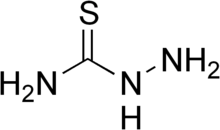Thiosemicarbazide
Jump to navigation
Jump to search

| |
| Names | |
|---|---|
| Preferred IUPAC name
Hydrazinecarbothioamide[1] | |
| Other names
N-Aminothiourea, Aminothiourea
| |
| Identifiers | |
3D model (JSmol)
|
|
| ChEMBL | |
| ChemSpider | |
| ECHA InfoCard | 100.001.077 |
| EC Number |
|
PubChem CID
|
|
| UNII | |
| UN number | 2811 2771 |
CompTox Dashboard (EPA)
|
|
| |
| |
| Properties | |
| CH5N3S | |
| Molar mass | 91.13 g·mol−1 |
| Appearance | white solid |
| Density | 1.465 g/cm3 |
| Melting point | 183 °C (361 °F; 456 K) |
| Hazards | |
| GHS labelling: | |

| |
| Danger | |
| H300, H412 | |
| P264, P270, P273, P301+P310, P321, P330, P405, P501 | |
Except where otherwise noted, data are given for materials in their standard state (at 25 °C [77 °F], 100 kPa).
| |
Thiosemicarbazide is the chemical compound with the formula H2NC(S)NHNH2. A white, odorless solid, it is related to thiourea (H2NC(S)NH2) by the insertion of an NH center. They are commonly used as ligands for transition metals.[2] Many thiosemicarbazides are known. These feature an organic substituent in place of one or more H's of the parent molecule. 4-Methyl-3-thiosemicarbazide is a simple example.
According to X-ray crystallography, the CSN3 core of the molecule is planar as are the three H's nearest the thiocarbonyl group.[3]
Reactions
Thiosemicarbazides are precursors to thiosemicarbazones. They are precursors to heterocycles.[4] Formylation of thiosemicarbazide provides access to triazole.[5]
References
- ^ International Union of Pure and Applied Chemistry (2014). Nomenclature of Organic Chemistry: IUPAC Recommendations and Preferred Names 2013. The Royal Society of Chemistry. p. 1003. doi:10.1039/9781849733069. ISBN 978-0-85404-182-4.
- ^ Campbell, Michel J.M. (1975). "Transition metal complexes of thiosemicarbazide and thiosemicarbazones". Coordination Chemistry Reviews. 15 (2–3): 279–319. doi:10.1016/S0010-8545(00)80276-3.
- ^ Andreetti, G. D.; Domiano, P.; Gasparri, G. F.; Nardelli, M.; Sgarabotto, P. (1970). "Hydrogen bonding in thiosemicarbazide". Acta Crystallographica Section B: Structural Crystallography and Crystal Chemistry. 26 (7): 1005–1009. Bibcode:1970AcCrB..26.1005A. doi:10.1107/S0567740870003497.
- ^ Gazieva, Galina A.; Kravchenko, Angelina N. (2012). "Thiosemicarbazides in the synthesis of five- and six-membered heterocyclic compounds". Russian Chemical Reviews. 81 (6): 494–523. Bibcode:2012RuCRv..81..494G. doi:10.1070/RC2012v081n06ABEH004235. S2CID 96691115.
- ^ C. Ainsworth (1960). "1,2,4-Triazole". Organic Syntheses. 40: 99. doi:10.15227/orgsyn.040.0099.
Categories:
- Articles without InChI source
- Articles without KEGG source
- ECHA InfoCard ID from Wikidata
- Chembox having GHS data
- Articles containing unverified chemical infoboxes
- Articles with short description
- Short description matches Wikidata
- Articles with GND identifiers
- Thiosemicarbazones
- Functional groups
- Semicarbazides